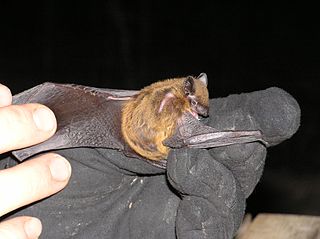
Vespertilionidae is a family of microbats, of the order Chiroptera, flying, insect-eating mammals variously described as the common, vesper, or simple nosed bats. The vespertilionid family is the most diverse and widely distributed of bat families, specialised in many forms to occupy a range of habitats and ecological circumstances, and it is frequently observed or the subject of research. The facial features of the species are often simple, as they mainly rely on vocally emitted echolocation. The tails of the species are enclosed by the lower flight membranes between the legs. Over 300 species are distributed all over the world, on every continent except Antarctica. It owes its name to the genus Vespertilio, which takes its name from a word for bat, vespertilio, derived from the Latin term vesper meaning 'evening'; they are termed "evening bats" and were once referred to as "evening birds".

Nycticeius is a small genus of bats in the vesper bat family, Vespertilionidae, and the only member of the tribe Nycticeiini. It contains three species, the evening bat, the Cuban evening bat and Nycticeius aenobarbus. Some authorities include several other Old World species in Nycticeius, but recent genetic work shows that is a completely New World genus. Nycticeius is of Greek and Latin origin, meaning "belonging to the night".

The evening bat is a species of bat in the vesper bat family that is native to North America. Hunting at night, they eat beetles, moths, and other flying insects.

The little goblin bat is a species of bat in the family Molossidae, the free-tailed bats. It is endemic to Cuba.

The yellow-striped pygmy eleuth, also known as the yellow-striped dwarf frog, is a species of frog in the family Eleutherodactylidae from closed mesic and xeric forests in Cuba.

The Monte Iberia eleuth, also known as the Monte Iberia dwarf frog, is a species of eleutherodactylid frog. It is critically endangered and endemic to rainforest in a small part of easternmost Cuba. It is the smallest frog in the Northern Hemisphere and the third smallest frog in the world, at about 10 mm (0.4 in) in snout–to–vent length.

The big-eared brown bat is a species of vesper bat found in Argentina, Paraguay, and Chile.

Schlieffen's serotine, also known as Schlieffen's bat or Schlieffen's twilight bat, is a species of vesper bat found in Africa. It has been placed in numerous genera since its first description in 1859, but morphological and genetic studies have confirmed it as the only species in the genus Nycticeinops. It is named for the collector of the original specimen, Wilhelm von Schlieffen-Schlieffiennburg.

Rüppell's or the greater broad-nosed bat is a species of vespertilionid microbat found in eastern Australia.

The Seminole bat is a species of bat in the family Vespertilionidae.

Eleutherodactylus cubanus is a species of frog in the family Eleutherodactylidae found in Cuba. Its natural habitats are tropical moist montane forest. It is threatened by habitat loss.
Eleutherodactylus jaumei is a species of frog in the family Eleutherodactylidae. This critically endangered species is endemic to a tiny area in Sierra Maestra in southeastern Cuba, where it mostly lives in closed mesic forest.

Eleutherodactylus orientalis, the Oriental robber frog or Baracoa dwarf frog, is a species of frog in the family Eleutherodactylidae. It is endemic to the vicinity of El Yunque, Baracoa, in easternmost Cuba. Although locally common, it requires undisturbed moist forest and has a tiny range, making it critically endangered from habitat loss and degradation.

The buffy flower bat is a species of bat in the leaf-nosed bat family, Phyllostomidae. It is found in the Bahamas, the Cayman Islands, Cuba, and Jamaica.

The Cuban flower bat, also called Poey's flower bat, is a species of bat in the family Phyllostomidae. It is found on the Caribbean islands of Cuba and Hispaniola.

The cinnamon red bat is a species of bat in the family Vespertilionidae. It was first described from a specimen that had been collected in Chile. For more than one hundred years after its initial description, it was largely considered a synonym of the eastern red bat. From the 1980s onward, it was frequently recognized as distinct from the eastern red bat due to its fur coloration and differences in range. It has deep red fur, lacking white "frosting" on the tips of individual hairs seen in other members of Lasiurus. It has a forearm length of 39–42 mm (1.5–1.7 in) and a weight of 9.5–11.0 g (0.34–0.39 oz).
The Cuban yellow bat is a species of bat from the family Vespertilioninae. It was previously included as a subspecies of the northern yellow bat, a species that has a similar ecology and biology. The species is endemic to Cuba, specifically the Las Villas Province in Cienfuegos, and it is listed under the IUCN Red List as vulnerable due to its ongoing population reduction and relatively small geographic range.
Pfeiffer's red bat is a species of bat from the family Vespertilioninae and is endemic to Cuba. It is listed as Near Threatened by the IUCN Red List due to a significant population decline, caused by human population density on its endemic island, habitat conversion, and hurricanes. The species is likely insectivorous; fecal matter samples from a single bat contained only beetles. It may be a subspecies of the Seminole bat.
Temminck's mysterious bat is a species of bat of the family Vespertilionidae.














